Electrocardiogram Interpretation Report: ECG 1 & ECG 2 Analysis
VerifiedAdded on 2021/04/17
|8
|2088
|82
Report
AI Summary
This report provides a detailed interpretation of two electrocardiograms (ECGs). ECG 1 reveals a first-degree heart block, characterized by a prolonged PR interval, indicating a delay in electrical conduction from the sinoatrial node to the ventricles. The report explains the normal sinus rhythm, cardiac axis, and QRS complex, along with the interpretation and management strategies, which primarily involve identifying and treating the underlying causes such as coronary artery disease or electrolyte imbalances. ECG 2 indicates left ventricular hypertrophy (LVH), evidenced by R waves greater than 25mm on electrodes V5 and V6, suggesting increased workload on the left ventricle. The report explains the patient's bradycardia and normal PR interval, the significance of the QRS complex, and provides a detailed analysis of the ECG findings. The report also discusses the management of LVH, which includes lifestyle modifications such as exercise and diet, and medical interventions such as ACE inhibitors, ARBs, calcium channel blockers, and diuretics. References are also included to support the interpretation of ECGs.
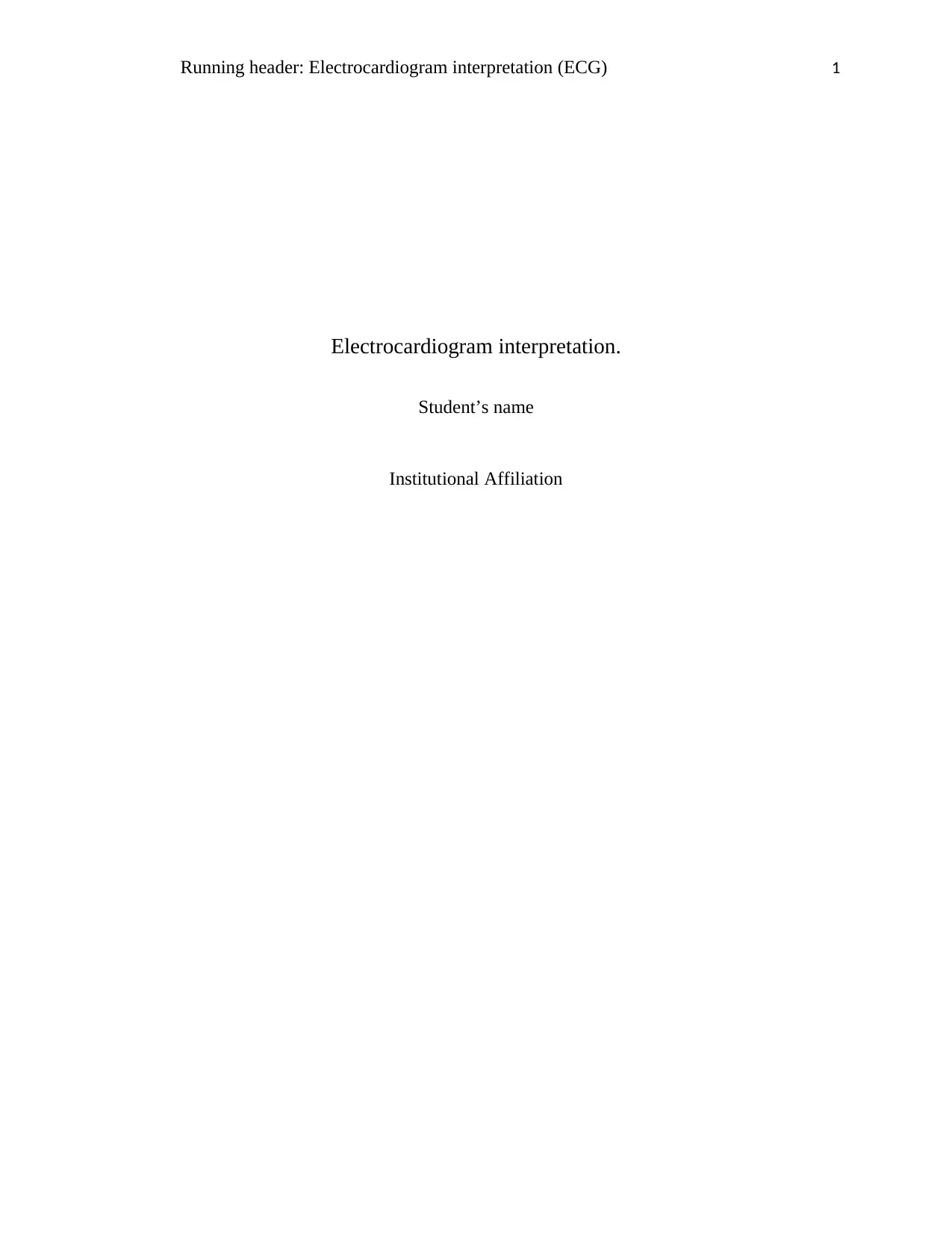
Running header: Electrocardiogram interpretation (ECG) 1
Electrocardiogram interpretation.
Student’s name
Institutional Affiliation
Electrocardiogram interpretation.
Student’s name
Institutional Affiliation
Paraphrase This Document
Need a fresh take? Get an instant paraphrase of this document with our AI Paraphraser
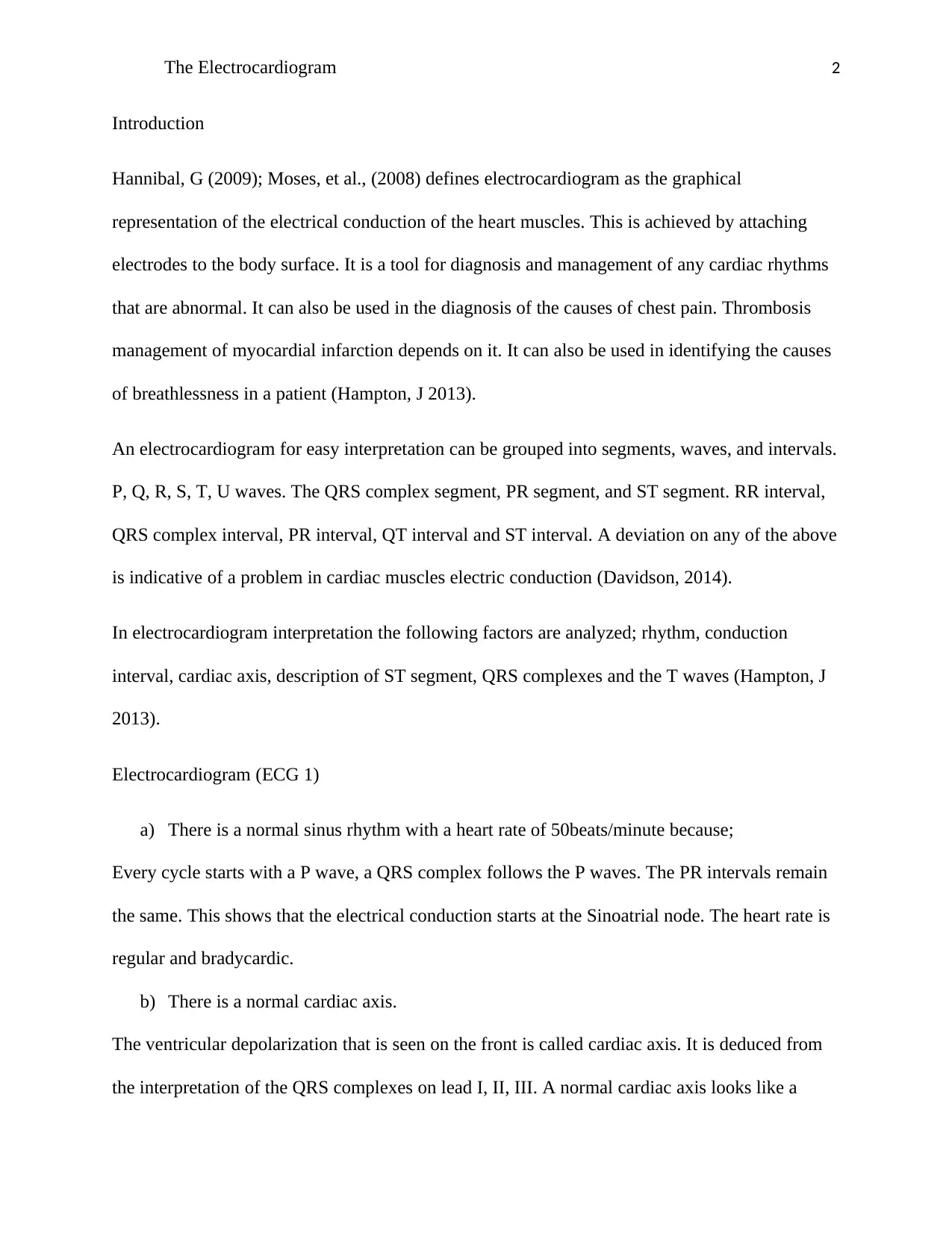
The Electrocardiogram 2
Introduction
Hannibal, G (2009); Moses, et al., (2008) defines electrocardiogram as the graphical
representation of the electrical conduction of the heart muscles. This is achieved by attaching
electrodes to the body surface. It is a tool for diagnosis and management of any cardiac rhythms
that are abnormal. It can also be used in the diagnosis of the causes of chest pain. Thrombosis
management of myocardial infarction depends on it. It can also be used in identifying the causes
of breathlessness in a patient (Hampton, J 2013).
An electrocardiogram for easy interpretation can be grouped into segments, waves, and intervals.
P, Q, R, S, T, U waves. The QRS complex segment, PR segment, and ST segment. RR interval,
QRS complex interval, PR interval, QT interval and ST interval. A deviation on any of the above
is indicative of a problem in cardiac muscles electric conduction (Davidson, 2014).
In electrocardiogram interpretation the following factors are analyzed; rhythm, conduction
interval, cardiac axis, description of ST segment, QRS complexes and the T waves (Hampton, J
2013).
Electrocardiogram (ECG 1)
a) There is a normal sinus rhythm with a heart rate of 50beats/minute because;
Every cycle starts with a P wave, a QRS complex follows the P waves. The PR intervals remain
the same. This shows that the electrical conduction starts at the Sinoatrial node. The heart rate is
regular and bradycardic.
b) There is a normal cardiac axis.
The ventricular depolarization that is seen on the front is called cardiac axis. It is deduced from
the interpretation of the QRS complexes on lead I, II, III. A normal cardiac axis looks like a
Introduction
Hannibal, G (2009); Moses, et al., (2008) defines electrocardiogram as the graphical
representation of the electrical conduction of the heart muscles. This is achieved by attaching
electrodes to the body surface. It is a tool for diagnosis and management of any cardiac rhythms
that are abnormal. It can also be used in the diagnosis of the causes of chest pain. Thrombosis
management of myocardial infarction depends on it. It can also be used in identifying the causes
of breathlessness in a patient (Hampton, J 2013).
An electrocardiogram for easy interpretation can be grouped into segments, waves, and intervals.
P, Q, R, S, T, U waves. The QRS complex segment, PR segment, and ST segment. RR interval,
QRS complex interval, PR interval, QT interval and ST interval. A deviation on any of the above
is indicative of a problem in cardiac muscles electric conduction (Davidson, 2014).
In electrocardiogram interpretation the following factors are analyzed; rhythm, conduction
interval, cardiac axis, description of ST segment, QRS complexes and the T waves (Hampton, J
2013).
Electrocardiogram (ECG 1)
a) There is a normal sinus rhythm with a heart rate of 50beats/minute because;
Every cycle starts with a P wave, a QRS complex follows the P waves. The PR intervals remain
the same. This shows that the electrical conduction starts at the Sinoatrial node. The heart rate is
regular and bradycardic.
b) There is a normal cardiac axis.
The ventricular depolarization that is seen on the front is called cardiac axis. It is deduced from
the interpretation of the QRS complexes on lead I, II, III. A normal cardiac axis looks like a

The Electrocardiogram 3
clock moving from 1100hrs to 0500hrs. The deflections on these leads are usually upright. For a
normal cardiac axis, the lead II is more positive than the rest (Currey et al., (2005). All of them
shows a positive deflection and the lead II deflection is most positive.
c) Prolonged PR interval 240ms.
PR interval is measured from the start atrial depolarization that is the P wave to the start of
ventricular depolarization that is QRS complex. The normal ranges are 120ms-200ms.
d) The QRS segment is normal.
A representation of ventricular depolarization. Has the Q, R, S waves. In V1, V2, V3, and V4 the
S waves are deeper than the R waves which is normal. V5, V6 the R waves are longer than S
waves which are normal.
e) QRS interval is normal, 120ms.
This represents the ventricular contraction, both the left and the right ventricles. It should not 120
milliseconds.
f) ST segment is normal.
It is isoelectric that is, it lies on the same level as the sections between the T waves and that of
the subsequent P wave. It is an indication of sufficient cardiac muscle perfusion.
Interpretation
This is indicative of first-degree heart block. This is because each depolarization wave
originates from the Sino-atrial node, P wave. The P waves atrial depolarization) is followed by a
ventricular depolarization QRS complex wave. This is conduction in the ventricles.
clock moving from 1100hrs to 0500hrs. The deflections on these leads are usually upright. For a
normal cardiac axis, the lead II is more positive than the rest (Currey et al., (2005). All of them
shows a positive deflection and the lead II deflection is most positive.
c) Prolonged PR interval 240ms.
PR interval is measured from the start atrial depolarization that is the P wave to the start of
ventricular depolarization that is QRS complex. The normal ranges are 120ms-200ms.
d) The QRS segment is normal.
A representation of ventricular depolarization. Has the Q, R, S waves. In V1, V2, V3, and V4 the
S waves are deeper than the R waves which is normal. V5, V6 the R waves are longer than S
waves which are normal.
e) QRS interval is normal, 120ms.
This represents the ventricular contraction, both the left and the right ventricles. It should not 120
milliseconds.
f) ST segment is normal.
It is isoelectric that is, it lies on the same level as the sections between the T waves and that of
the subsequent P wave. It is an indication of sufficient cardiac muscle perfusion.
Interpretation
This is indicative of first-degree heart block. This is because each depolarization wave
originates from the Sino-atrial node, P wave. The P waves atrial depolarization) is followed by a
ventricular depolarization QRS complex wave. This is conduction in the ventricles.
⊘ This is a preview!⊘
Do you want full access?
Subscribe today to unlock all pages.

Trusted by 1+ million students worldwide
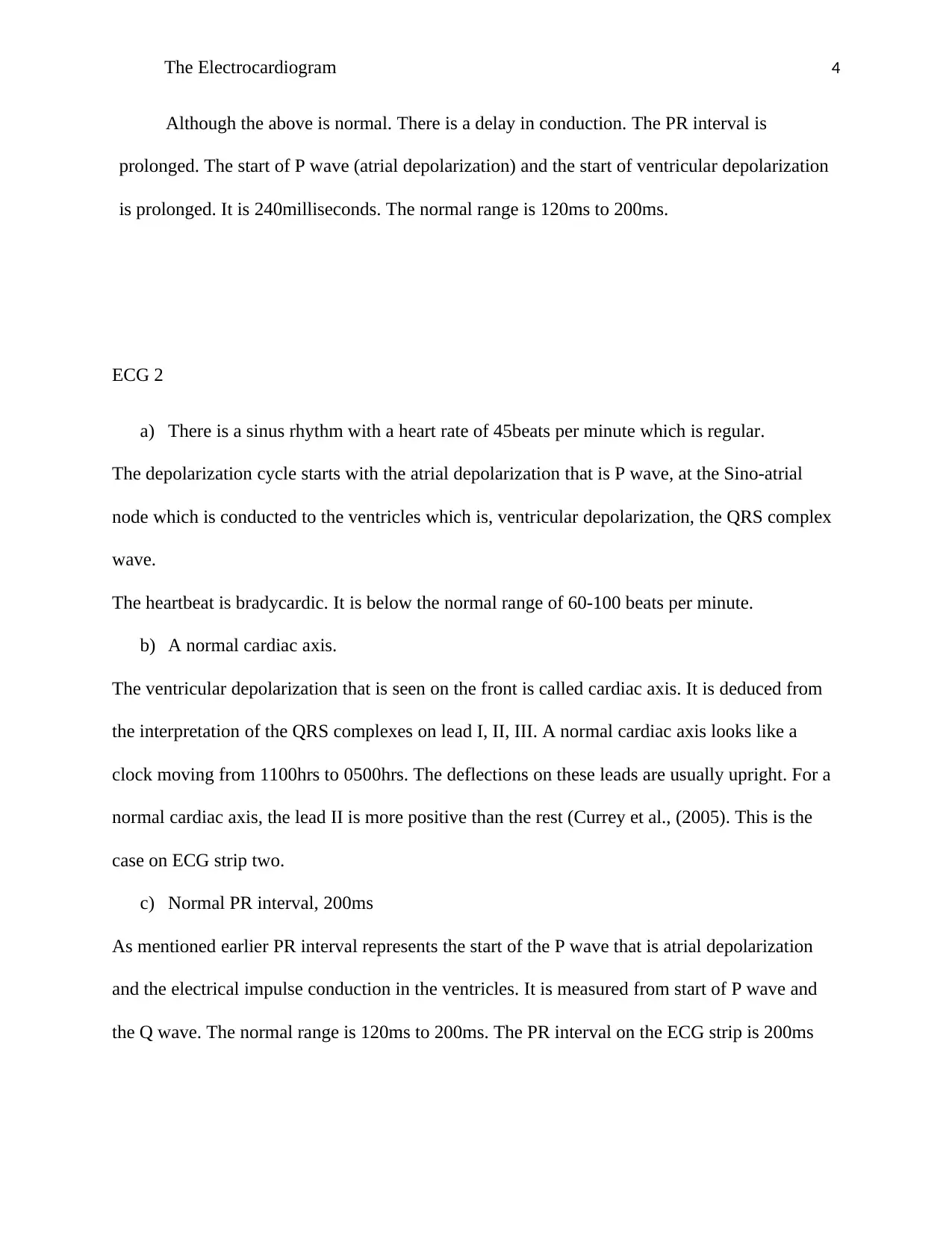
The Electrocardiogram 4
Although the above is normal. There is a delay in conduction. The PR interval is
prolonged. The start of P wave (atrial depolarization) and the start of ventricular depolarization
is prolonged. It is 240milliseconds. The normal range is 120ms to 200ms.
ECG 2
a) There is a sinus rhythm with a heart rate of 45beats per minute which is regular.
The depolarization cycle starts with the atrial depolarization that is P wave, at the Sino-atrial
node which is conducted to the ventricles which is, ventricular depolarization, the QRS complex
wave.
The heartbeat is bradycardic. It is below the normal range of 60-100 beats per minute.
b) A normal cardiac axis.
The ventricular depolarization that is seen on the front is called cardiac axis. It is deduced from
the interpretation of the QRS complexes on lead I, II, III. A normal cardiac axis looks like a
clock moving from 1100hrs to 0500hrs. The deflections on these leads are usually upright. For a
normal cardiac axis, the lead II is more positive than the rest (Currey et al., (2005). This is the
case on ECG strip two.
c) Normal PR interval, 200ms
As mentioned earlier PR interval represents the start of the P wave that is atrial depolarization
and the electrical impulse conduction in the ventricles. It is measured from start of P wave and
the Q wave. The normal range is 120ms to 200ms. The PR interval on the ECG strip is 200ms
Although the above is normal. There is a delay in conduction. The PR interval is
prolonged. The start of P wave (atrial depolarization) and the start of ventricular depolarization
is prolonged. It is 240milliseconds. The normal range is 120ms to 200ms.
ECG 2
a) There is a sinus rhythm with a heart rate of 45beats per minute which is regular.
The depolarization cycle starts with the atrial depolarization that is P wave, at the Sino-atrial
node which is conducted to the ventricles which is, ventricular depolarization, the QRS complex
wave.
The heartbeat is bradycardic. It is below the normal range of 60-100 beats per minute.
b) A normal cardiac axis.
The ventricular depolarization that is seen on the front is called cardiac axis. It is deduced from
the interpretation of the QRS complexes on lead I, II, III. A normal cardiac axis looks like a
clock moving from 1100hrs to 0500hrs. The deflections on these leads are usually upright. For a
normal cardiac axis, the lead II is more positive than the rest (Currey et al., (2005). This is the
case on ECG strip two.
c) Normal PR interval, 200ms
As mentioned earlier PR interval represents the start of the P wave that is atrial depolarization
and the electrical impulse conduction in the ventricles. It is measured from start of P wave and
the Q wave. The normal range is 120ms to 200ms. The PR interval on the ECG strip is 200ms
Paraphrase This Document
Need a fresh take? Get an instant paraphrase of this document with our AI Paraphraser
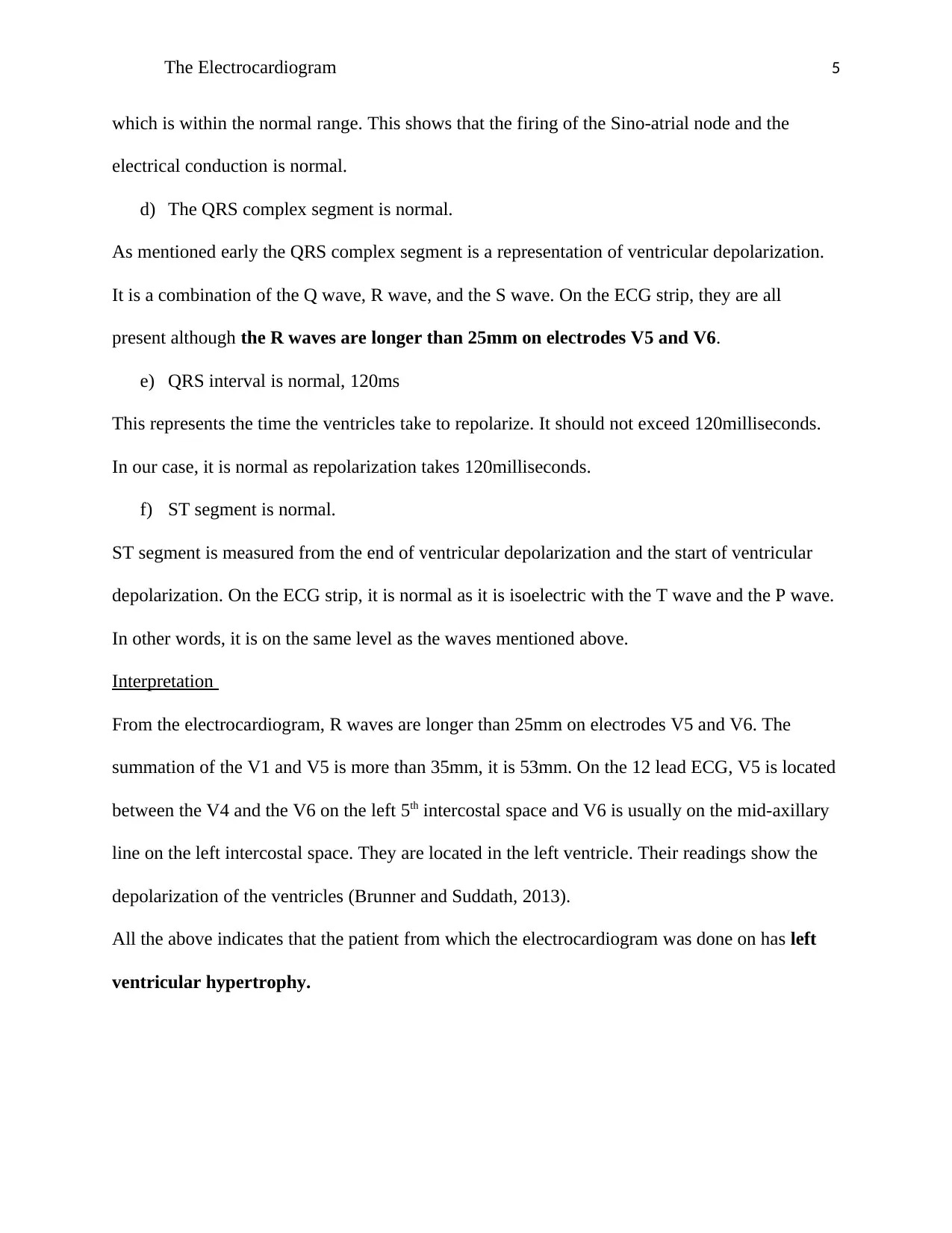
The Electrocardiogram 5
which is within the normal range. This shows that the firing of the Sino-atrial node and the
electrical conduction is normal.
d) The QRS complex segment is normal.
As mentioned early the QRS complex segment is a representation of ventricular depolarization.
It is a combination of the Q wave, R wave, and the S wave. On the ECG strip, they are all
present although the R waves are longer than 25mm on electrodes V5 and V6.
e) QRS interval is normal, 120ms
This represents the time the ventricles take to repolarize. It should not exceed 120milliseconds.
In our case, it is normal as repolarization takes 120milliseconds.
f) ST segment is normal.
ST segment is measured from the end of ventricular depolarization and the start of ventricular
depolarization. On the ECG strip, it is normal as it is isoelectric with the T wave and the P wave.
In other words, it is on the same level as the waves mentioned above.
Interpretation
From the electrocardiogram, R waves are longer than 25mm on electrodes V5 and V6. The
summation of the V1 and V5 is more than 35mm, it is 53mm. On the 12 lead ECG, V5 is located
between the V4 and the V6 on the left 5th intercostal space and V6 is usually on the mid-axillary
line on the left intercostal space. They are located in the left ventricle. Their readings show the
depolarization of the ventricles (Brunner and Suddath, 2013).
All the above indicates that the patient from which the electrocardiogram was done on has left
ventricular hypertrophy.
which is within the normal range. This shows that the firing of the Sino-atrial node and the
electrical conduction is normal.
d) The QRS complex segment is normal.
As mentioned early the QRS complex segment is a representation of ventricular depolarization.
It is a combination of the Q wave, R wave, and the S wave. On the ECG strip, they are all
present although the R waves are longer than 25mm on electrodes V5 and V6.
e) QRS interval is normal, 120ms
This represents the time the ventricles take to repolarize. It should not exceed 120milliseconds.
In our case, it is normal as repolarization takes 120milliseconds.
f) ST segment is normal.
ST segment is measured from the end of ventricular depolarization and the start of ventricular
depolarization. On the ECG strip, it is normal as it is isoelectric with the T wave and the P wave.
In other words, it is on the same level as the waves mentioned above.
Interpretation
From the electrocardiogram, R waves are longer than 25mm on electrodes V5 and V6. The
summation of the V1 and V5 is more than 35mm, it is 53mm. On the 12 lead ECG, V5 is located
between the V4 and the V6 on the left 5th intercostal space and V6 is usually on the mid-axillary
line on the left intercostal space. They are located in the left ventricle. Their readings show the
depolarization of the ventricles (Brunner and Suddath, 2013).
All the above indicates that the patient from which the electrocardiogram was done on has left
ventricular hypertrophy.
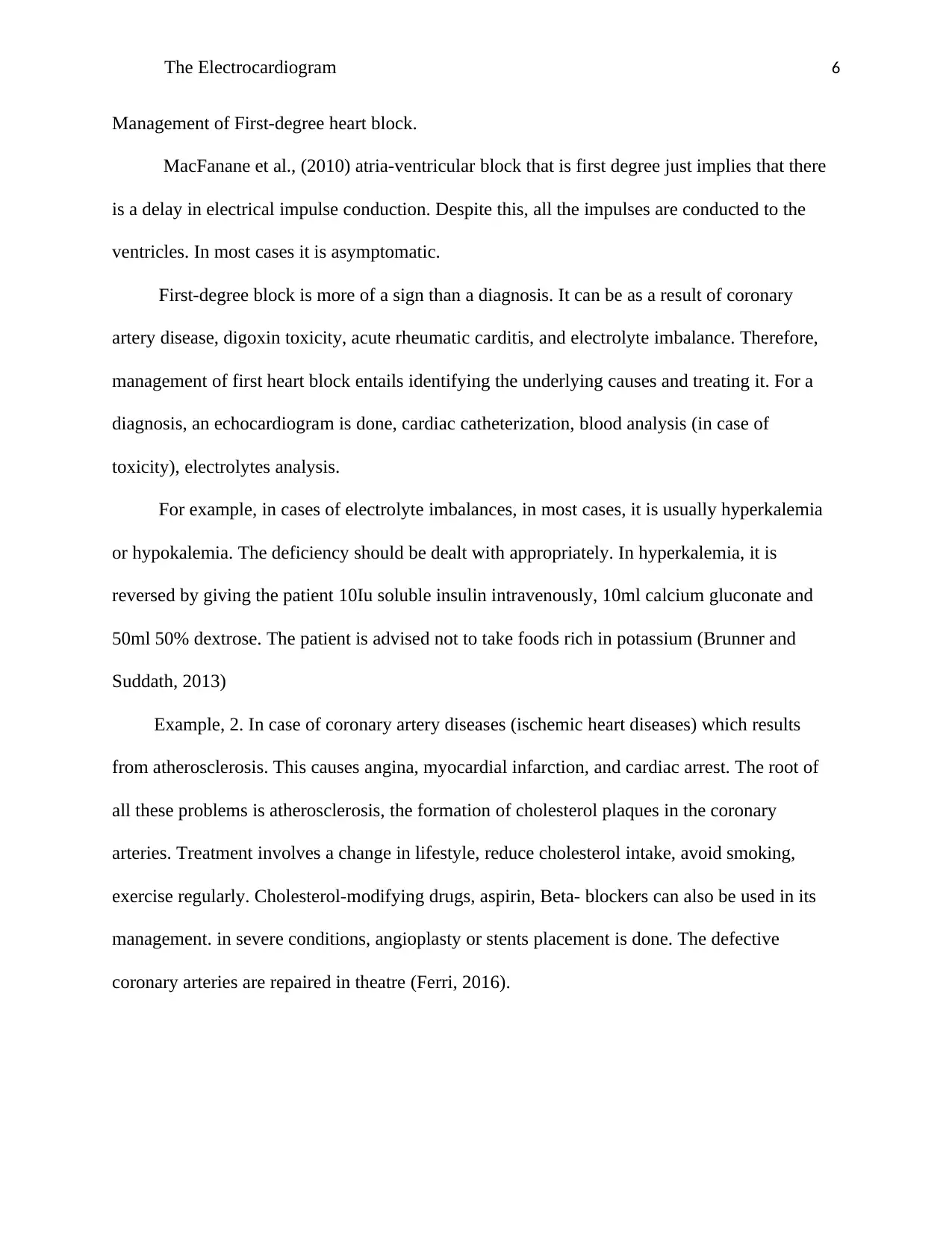
The Electrocardiogram 6
Management of First-degree heart block.
MacFanane et al., (2010) atria-ventricular block that is first degree just implies that there
is a delay in electrical impulse conduction. Despite this, all the impulses are conducted to the
ventricles. In most cases it is asymptomatic.
First-degree block is more of a sign than a diagnosis. It can be as a result of coronary
artery disease, digoxin toxicity, acute rheumatic carditis, and electrolyte imbalance. Therefore,
management of first heart block entails identifying the underlying causes and treating it. For a
diagnosis, an echocardiogram is done, cardiac catheterization, blood analysis (in case of
toxicity), electrolytes analysis.
For example, in cases of electrolyte imbalances, in most cases, it is usually hyperkalemia
or hypokalemia. The deficiency should be dealt with appropriately. In hyperkalemia, it is
reversed by giving the patient 10Iu soluble insulin intravenously, 10ml calcium gluconate and
50ml 50% dextrose. The patient is advised not to take foods rich in potassium (Brunner and
Suddath, 2013)
Example, 2. In case of coronary artery diseases (ischemic heart diseases) which results
from atherosclerosis. This causes angina, myocardial infarction, and cardiac arrest. The root of
all these problems is atherosclerosis, the formation of cholesterol plaques in the coronary
arteries. Treatment involves a change in lifestyle, reduce cholesterol intake, avoid smoking,
exercise regularly. Cholesterol-modifying drugs, aspirin, Beta- blockers can also be used in its
management. in severe conditions, angioplasty or stents placement is done. The defective
coronary arteries are repaired in theatre (Ferri, 2016).
Management of First-degree heart block.
MacFanane et al., (2010) atria-ventricular block that is first degree just implies that there
is a delay in electrical impulse conduction. Despite this, all the impulses are conducted to the
ventricles. In most cases it is asymptomatic.
First-degree block is more of a sign than a diagnosis. It can be as a result of coronary
artery disease, digoxin toxicity, acute rheumatic carditis, and electrolyte imbalance. Therefore,
management of first heart block entails identifying the underlying causes and treating it. For a
diagnosis, an echocardiogram is done, cardiac catheterization, blood analysis (in case of
toxicity), electrolytes analysis.
For example, in cases of electrolyte imbalances, in most cases, it is usually hyperkalemia
or hypokalemia. The deficiency should be dealt with appropriately. In hyperkalemia, it is
reversed by giving the patient 10Iu soluble insulin intravenously, 10ml calcium gluconate and
50ml 50% dextrose. The patient is advised not to take foods rich in potassium (Brunner and
Suddath, 2013)
Example, 2. In case of coronary artery diseases (ischemic heart diseases) which results
from atherosclerosis. This causes angina, myocardial infarction, and cardiac arrest. The root of
all these problems is atherosclerosis, the formation of cholesterol plaques in the coronary
arteries. Treatment involves a change in lifestyle, reduce cholesterol intake, avoid smoking,
exercise regularly. Cholesterol-modifying drugs, aspirin, Beta- blockers can also be used in its
management. in severe conditions, angioplasty or stents placement is done. The defective
coronary arteries are repaired in theatre (Ferri, 2016).
⊘ This is a preview!⊘
Do you want full access?
Subscribe today to unlock all pages.

Trusted by 1+ million students worldwide
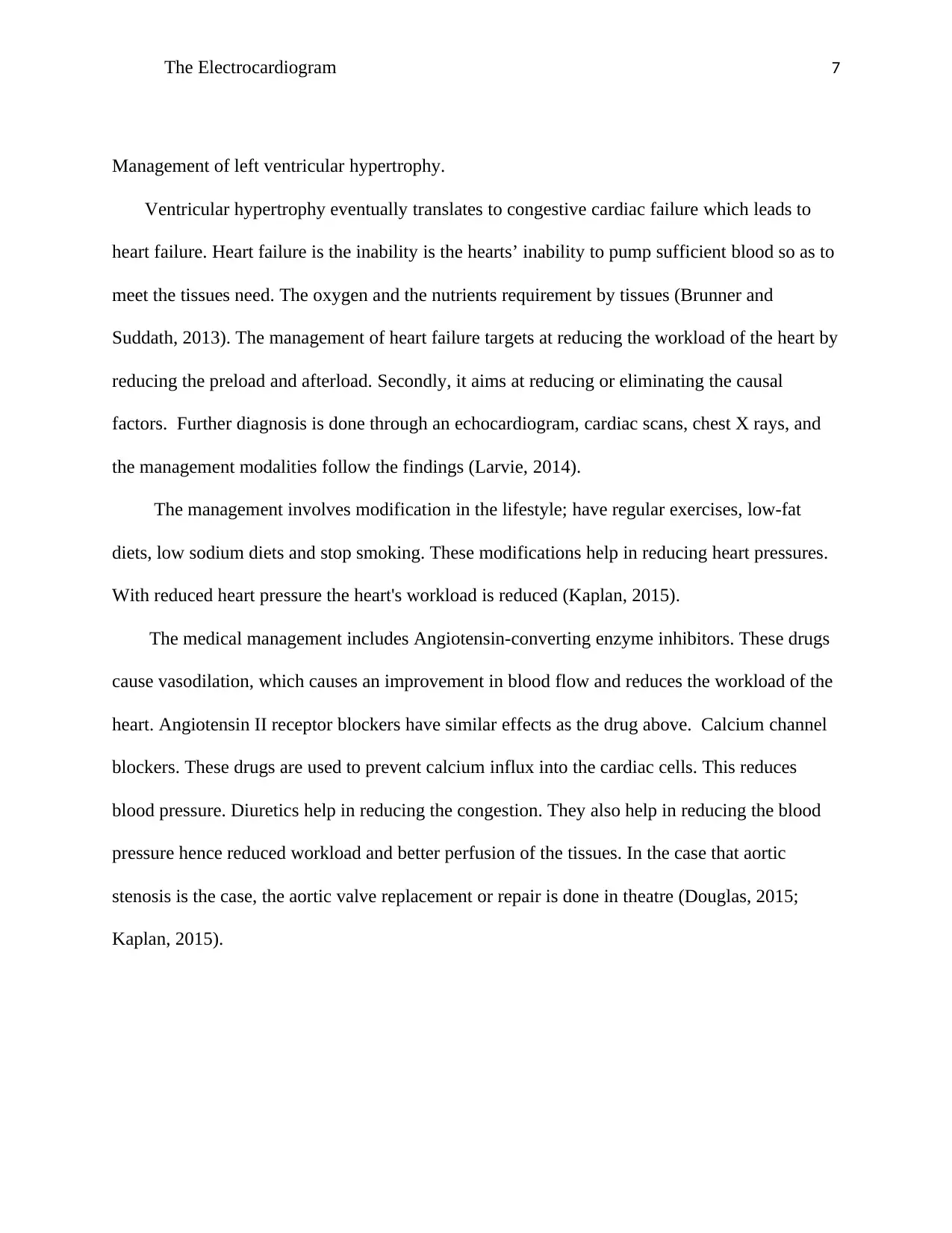
The Electrocardiogram 7
Management of left ventricular hypertrophy.
Ventricular hypertrophy eventually translates to congestive cardiac failure which leads to
heart failure. Heart failure is the inability is the hearts’ inability to pump sufficient blood so as to
meet the tissues need. The oxygen and the nutrients requirement by tissues (Brunner and
Suddath, 2013). The management of heart failure targets at reducing the workload of the heart by
reducing the preload and afterload. Secondly, it aims at reducing or eliminating the causal
factors. Further diagnosis is done through an echocardiogram, cardiac scans, chest X rays, and
the management modalities follow the findings (Larvie, 2014).
The management involves modification in the lifestyle; have regular exercises, low-fat
diets, low sodium diets and stop smoking. These modifications help in reducing heart pressures.
With reduced heart pressure the heart's workload is reduced (Kaplan, 2015).
The medical management includes Angiotensin-converting enzyme inhibitors. These drugs
cause vasodilation, which causes an improvement in blood flow and reduces the workload of the
heart. Angiotensin II receptor blockers have similar effects as the drug above. Calcium channel
blockers. These drugs are used to prevent calcium influx into the cardiac cells. This reduces
blood pressure. Diuretics help in reducing the congestion. They also help in reducing the blood
pressure hence reduced workload and better perfusion of the tissues. In the case that aortic
stenosis is the case, the aortic valve replacement or repair is done in theatre (Douglas, 2015;
Kaplan, 2015).
Management of left ventricular hypertrophy.
Ventricular hypertrophy eventually translates to congestive cardiac failure which leads to
heart failure. Heart failure is the inability is the hearts’ inability to pump sufficient blood so as to
meet the tissues need. The oxygen and the nutrients requirement by tissues (Brunner and
Suddath, 2013). The management of heart failure targets at reducing the workload of the heart by
reducing the preload and afterload. Secondly, it aims at reducing or eliminating the causal
factors. Further diagnosis is done through an echocardiogram, cardiac scans, chest X rays, and
the management modalities follow the findings (Larvie, 2014).
The management involves modification in the lifestyle; have regular exercises, low-fat
diets, low sodium diets and stop smoking. These modifications help in reducing heart pressures.
With reduced heart pressure the heart's workload is reduced (Kaplan, 2015).
The medical management includes Angiotensin-converting enzyme inhibitors. These drugs
cause vasodilation, which causes an improvement in blood flow and reduces the workload of the
heart. Angiotensin II receptor blockers have similar effects as the drug above. Calcium channel
blockers. These drugs are used to prevent calcium influx into the cardiac cells. This reduces
blood pressure. Diuretics help in reducing the congestion. They also help in reducing the blood
pressure hence reduced workload and better perfusion of the tissues. In the case that aortic
stenosis is the case, the aortic valve replacement or repair is done in theatre (Douglas, 2015;
Kaplan, 2015).
Paraphrase This Document
Need a fresh take? Get an instant paraphrase of this document with our AI Paraphraser
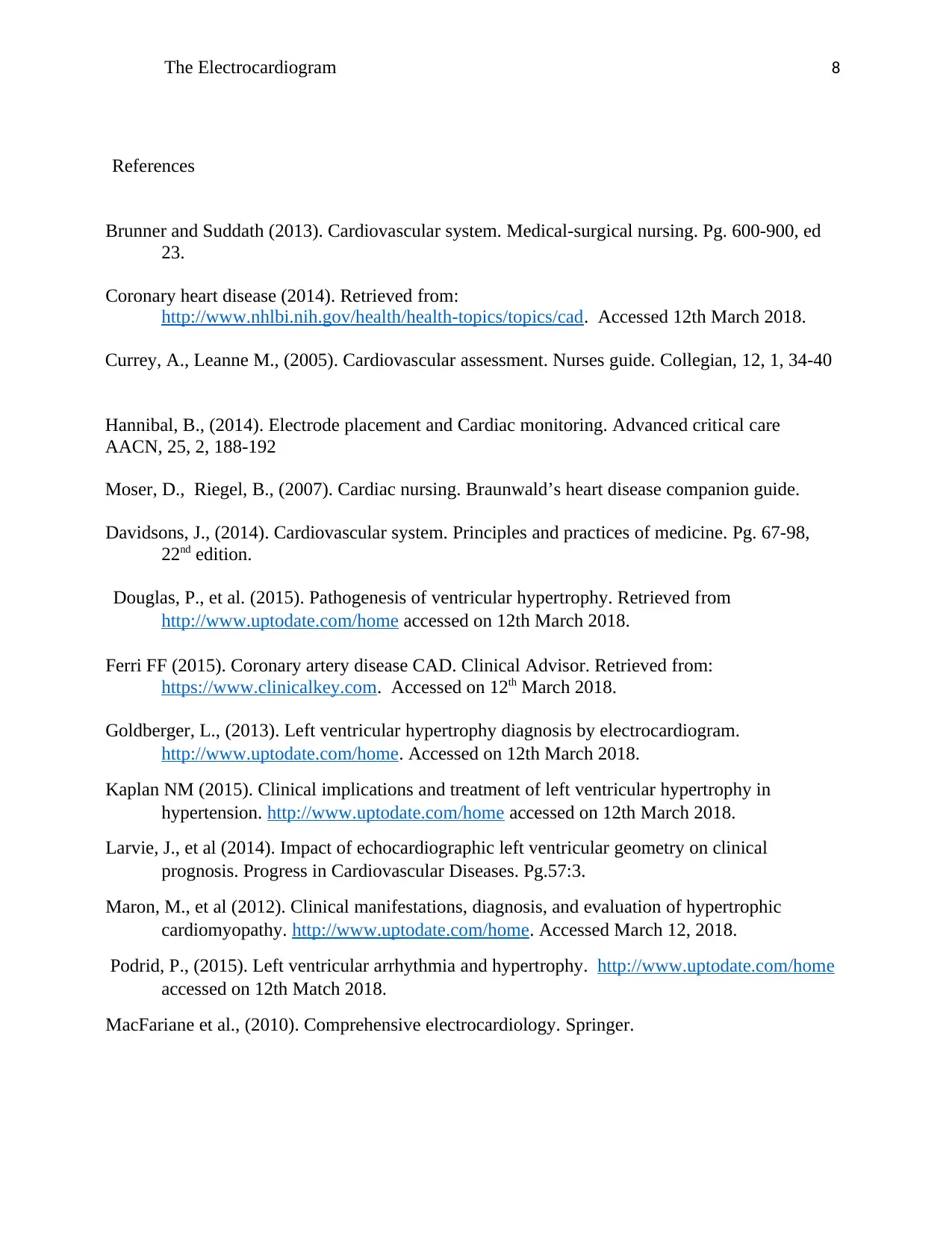
The Electrocardiogram 8
References
Brunner and Suddath (2013). Cardiovascular system. Medical-surgical nursing. Pg. 600-900, ed
23.
Coronary heart disease (2014). Retrieved from:
http://www.nhlbi.nih.gov/health/health-topics/topics/cad. Accessed 12th March 2018.
Currey, A., Leanne M., (2005). Cardiovascular assessment. Nurses guide. Collegian, 12, 1, 34-40
Hannibal, B., (2014). Electrode placement and Cardiac monitoring. Advanced critical care
AACN, 25, 2, 188-192
Moser, D., Riegel, B., (2007). Cardiac nursing. Braunwald’s heart disease companion guide.
Davidsons, J., (2014). Cardiovascular system. Principles and practices of medicine. Pg. 67-98,
22nd edition.
Douglas, P., et al. (2015). Pathogenesis of ventricular hypertrophy. Retrieved from
http://www.uptodate.com/home accessed on 12th March 2018.
Ferri FF (2015). Coronary artery disease CAD. Clinical Advisor. Retrieved from:
https://www.clinicalkey.com. Accessed on 12th March 2018.
Goldberger, L., (2013). Left ventricular hypertrophy diagnosis by electrocardiogram.
http://www.uptodate.com/home. Accessed on 12th March 2018.
Kaplan NM (2015). Clinical implications and treatment of left ventricular hypertrophy in
hypertension. http://www.uptodate.com/home accessed on 12th March 2018.
Larvie, J., et al (2014). Impact of echocardiographic left ventricular geometry on clinical
prognosis. Progress in Cardiovascular Diseases. Pg.57:3.
Maron, M., et al (2012). Clinical manifestations, diagnosis, and evaluation of hypertrophic
cardiomyopathy. http://www.uptodate.com/home. Accessed March 12, 2018.
Podrid, P., (2015). Left ventricular arrhythmia and hypertrophy. http://www.uptodate.com/home
accessed on 12th Match 2018.
MacFariane et al., (2010). Comprehensive electrocardiology. Springer.
References
Brunner and Suddath (2013). Cardiovascular system. Medical-surgical nursing. Pg. 600-900, ed
23.
Coronary heart disease (2014). Retrieved from:
http://www.nhlbi.nih.gov/health/health-topics/topics/cad. Accessed 12th March 2018.
Currey, A., Leanne M., (2005). Cardiovascular assessment. Nurses guide. Collegian, 12, 1, 34-40
Hannibal, B., (2014). Electrode placement and Cardiac monitoring. Advanced critical care
AACN, 25, 2, 188-192
Moser, D., Riegel, B., (2007). Cardiac nursing. Braunwald’s heart disease companion guide.
Davidsons, J., (2014). Cardiovascular system. Principles and practices of medicine. Pg. 67-98,
22nd edition.
Douglas, P., et al. (2015). Pathogenesis of ventricular hypertrophy. Retrieved from
http://www.uptodate.com/home accessed on 12th March 2018.
Ferri FF (2015). Coronary artery disease CAD. Clinical Advisor. Retrieved from:
https://www.clinicalkey.com. Accessed on 12th March 2018.
Goldberger, L., (2013). Left ventricular hypertrophy diagnosis by electrocardiogram.
http://www.uptodate.com/home. Accessed on 12th March 2018.
Kaplan NM (2015). Clinical implications and treatment of left ventricular hypertrophy in
hypertension. http://www.uptodate.com/home accessed on 12th March 2018.
Larvie, J., et al (2014). Impact of echocardiographic left ventricular geometry on clinical
prognosis. Progress in Cardiovascular Diseases. Pg.57:3.
Maron, M., et al (2012). Clinical manifestations, diagnosis, and evaluation of hypertrophic
cardiomyopathy. http://www.uptodate.com/home. Accessed March 12, 2018.
Podrid, P., (2015). Left ventricular arrhythmia and hypertrophy. http://www.uptodate.com/home
accessed on 12th Match 2018.
MacFariane et al., (2010). Comprehensive electrocardiology. Springer.
1 out of 8
Related Documents
Your All-in-One AI-Powered Toolkit for Academic Success.
+13062052269
info@desklib.com
Available 24*7 on WhatsApp / Email
![[object Object]](/_next/static/media/star-bottom.7253800d.svg)
Unlock your academic potential
Copyright © 2020–2025 A2Z Services. All Rights Reserved. Developed and managed by ZUCOL.





